
Solace from Space
Jennifer Marrie Burch

Solace from Space
Jennifer Marrie Burch
esis submitted to the faculty of
Virginia Polytechnic Institute and State University
in partial ful llment of the requirements for the degree of
Master of Landscape Architecture
in
Landscape Architecture
Paul Kelsch
Nathan Heavers
Marcia Feuerstein
April 13, 2021
Alexandria, Virginia
Keywords: Landscape Architecture, Mental Health, Urban Planning
© Jennifer Marrie Burch, 2021
Solace from Space
Jennifer Marrie Burch
ABSTRACT
Shinrin-yoku or forest bathing is the Japanese art of using the forest to relax. e
process takes about two hours to absorb the full bene ts of the forest. is does not provide
for an easy way to decompress if you are living or working in an urban environment. e
expansion of urbanism and decrease of green space across the country only furthers the
inaccessibility someone might face if they seek nature as their destination to de-stress.
ere needs to be a more accessible way to alleviate the harmful e ects of stress in an urban
atmosphere. e health bene ts from nature are numerous. is thesis focuses on the ways
landscape can quiet the mind and aid in calming the psychological stressors of a person
living in an urban environment. e use of expanse, beauty, and phytoncides combine
together to create the zones of this soothing landscape park. e importance of nding a
way to create a safe, healing environment is critical to the development of this site. Multiple
design ideologies are implemented to create a space that will aid in reducing strain on
the brain’s cognitive load capacity. is thesis shapes a park that provides a calming and
soothing escape for any person who seeks twenty minutes to relax and decompress before
returning to their work day. e Carlyle Solace Park is an example of how a therapeutic
space can be created in an urban environment.

Solace from Space
Jennifer Marrie Burch
GENERAL AUDIENCE ABSTRACT
Stress is debilitating. Mental illnesses are o en incapacitating. ‘ e brain has a mind of
its own’ is in fact no joke. Managing a person’s mental health in an urban environment is not easy.
Smog, car horns, tra c, o ce chatter, the smell of dumpsters or cigarettes as you walk down
the street. None of this will help someone when they are going through a depressive episode, a
panic or anxiety, or have exceeded the amount of stress their body can handle. ere has to be
a way to create a space that calms the mind and allows for reconnecting with your senses in the
environment. e Japanese call it shinrin-yoku or forest bathing. Forests are used to alleviate the
pressures of day to day stress and other mental or psychological ailments. To truly bene t from
shinrin-yoku, one must spend two hours amongst the trees in the forest. is does not provide
for an easy way to decompress if you are living or working in an urban environment. is thesis
explores the bene ts of three landscape types to create a park that can provide solace to the person
who is struggling with stress or a mental illness. e brain can be uncontrollable. It is important
to nd a way to relieve the pressures placed on it. Nature is healing. Cities need to maximize
therapeutic e ects of nature in their green spaces. e Carlyle Solace Park, designed in this thesis,
is an example of how a therapeutic space can be created in an urban environment.
DEDICATION
is thesis is dedicated to those su ering om mental health ailments.
I hope this helps inspire you to nd a space that can ease your pain and help you nd solace.
v

ACKNOWLEDGMENTS
I would like to thank my friends and family who assisted me on my thesis journey for
their love, unyielding support, and encouragement, especially Bill and Patti Burch,
Allison, Michael, and Zoe Harrigan, Pamela Sanchez, Becky Anzelone, and Chris Hampel.
My thesis co-hort who I would not have gotten this far without: Lynda Ramirez-Blust,
Michelle Mitchell, Ashley Coates, Rana Rahimi. My thesis committee for their feedback
and guidance: Paul Kelsch, Nate Heavers, and Marcia Feuerstein. ank you all so much
for helping me get to the nish line.
vi
TABLE OF CONTENTS
ABSTRACT
III
GENERAL AUDIENCE ABSTRACT
IV
D E D I C AT I O N
V
ACKNOWLEDGMENTS
VI
INTRODUCTION
1
20 MINUTES
5
SOFT FASCINATION
8
SITE SELECTION
9
URBAN FOREST
15
CARLYLE SOLACE PARK
19
MODEL
25
S AVA N N A H
27
ATTENTION RESTORATION THEORY
29
MEADOW
35
THE OUDOLF METHOD
37
THE RAINIER METHOD
39
S WA L E
45
FOREST
49
BIO-ENERGY & NEGATIVE IONS
51
PH Y TONCI DE S
55
CONCLUDING THOUGHTS
59
REFERENCES
61
vii

LIST OF FIGURES
figure 1 - photo from carlyle neighborhood
figure 2 - photo of grass textures
figure 3 - inspiration photo collage
figure 4 - alexandria african american heritage park (aaahp)
figure 5 - aaahp, hooff’s run view
figure 6 - sketch of walk at hooff’s run
figure 7 - photos from lake walk
figure 8 - sketch from lake walk
figure 9 - photos from various walks - falls church, va
figure 10 - eisenhower avenue, south - sketch
figure 11 - photo from john carlyle street looking south
figure 12 - existing site collage
figure 13 - site/empty lot collage
figure 14 - aaahp & empty lot site collage
figure 15 - urban forest site collage
figure 16 - site textures sketch
figure 17 - carlyle neighborhood, alexandria, va - aerial
figure 18 - carlyle solace park - original layout
figure 19 - carlyle solace park - final layout
figure 20 - carlyle solace park - cut/fill diagram
figure 21 - carlyle solace park - grading plan
figure 22 - carlyle solace park site - plan with section lines
figure 23 - site model
figure 24 - savannah section
figure 25 - savannah perspective
figure 26 - savannah plant list
figure 27 - savannah planting plan
figure 28 - plant texture collage
figure 29 - meadow section
figure 30 - textural details - oudolf’s planting at hummelo
viii
2
figure 31 - lurie garden - chicago, il - designed by oudolf
38
2
figure 32 - thomas rainier’s home garden - arlington, va
40
4
figure 33 - bio-retention planting - lancaster, pa - designed by phyto studio
40
5
figure 34 - meadow plan - ‘quilt’ view
41
6
figure 35 - meadow planting plan - matrix view
41
6
figure 36 - meadow planting plan
41
7
figure 37 - meadow plant list
42
7
figure 38 - meadow elevation
44
8
figure 40 - swale section
46
9
figure 39 - example of river rocks
46
10
figure 41 - swale planting plan
47
12
figure 42 - swale plant list
48
13
figure 43 - forest perspective
50
14
figure 44 - forest layers axonometric
52
16
figure 45 - forest plant list
53
17
figure 46 - forest planting plan
54
20
figure 47 - photo of conifers
55
21
figure 48 - forest center sketch
56
21
figure 49 - final collage
57
22
figure 50 - photo of pine needles
60
23
figure 51 - photo of forest
62
24
25
28
30
31
32
33
36
38
ix

x

INTRODUCTION
Stress and forest bathing di erent. Unfortunately, in America anxiety, and depression was the
- together became the impetus for mental health is o en not covered by starting point of my search for
this thesis. I have su ered from insurance companies, or if it is, the alternative mental health relief. I
anxiety and depression most of my paperwork alone is overwhelming. found Dr. Qing Li’s book, Forest
life. Mental health diagnoses usually Counselors and therapists are Bathing - How Trees Can Help You
lead to a roller coaster lifestyle — frequently independently owned Find Health and Happiness, lled
that is, some good days and some and costly. So, while one can with visually striking images of
bad ones. But the bad ones are pay out of pocket and wait to be lush green forests in Japan. is
harder than the typical ‘ at tire on partially reimbursed, it is not ideal. reminded me of my undergraduate
the way to work’ bad day. I entered e system or lack of a system studies in Japanese art history, and as
graduate school full time while also causes people to seek alternative a graduate student, Japanese gardens
working full time. My stress level forms of mental health care. While has become my favorite genre in
imploded, and the bad days led to organizations like Mental Health landscape architecture history. I le
anxiety attacks, massive waves of America are making strides with the bookstore with my new forest
overwhelming emotions, and many campaigns like #StoptheStigma and bathing book and started reading.
days of doubt, ultimately sent me on #B4Stage4, it is still hard for many
A er nishing Dr. Qing
this path pursuing stronger mental to seek help from a professional due Li’s book, shinrin-yoku, the Japanese
and physical health.
to cost, accessibility, availability, term for forest bathing, increased my
Mental health care is not awareness. e path to healthy fascination with Japanese culture.
a one size ts all solution. For mental health is full of obstacles. Dr. Li’s book explained the science
most, the best form of treatment
Perusing the ‘Self Help’ and research behind the healing
is a combination of talk therapy sections of bookstores, nding e ects spending time in nature has
and medication, but everyone is books on breathing, mindfulness, on the body. A two-hour forest bath
1
decreases the signs of stress on the
body signi cantly and creates huge
strides for those needing assistance
in stress management or mental
health struggles. ese two simple
ingredients (two hours and a forest)
are a prescription for a healthier
mind, but are actually harder to
nd in urban areas of the United
States, which is drastically losing
its green space. Street trees are
o en the closest a person gets to a
forest. How many cities have forests
within a 20-minute drive? ere
may be parks and green spaces, but
actual forests are dwindling. en
comes the ingredient of time. How
many people have two consecutive
hours in which they can unplug
from their life and go for a walk
in a forest? Driving out of the city
to a forest for a two hour hiatus is
not a practical component of the
workday. ere had to be a way to
harness the techniques and bene ts
of forest bathing in a shorter time
frame. Making this process more
attainable and accessible within city
limits is the opportunity to help
those su ering from mental illnesses
attain the relief o en needed on a
daily basis.
figure 1 - photo from carlyle neighborhood
figure 2 - photo of grass textures
2

figure 3 - inspiration photo collage
3
4

20 MINUTES
If forest bathing is shorter of the two time frames as the middle to be devoted time spent
impractical to someone in an urban the main constant, I estimated the in a healing landscape. Is twenty-
setting, how can this problem be amount of time someone is able to minutes be enough time to restore
resolved? How much time does devote to extracurricular activity the mind and body from stress?
someone actually have during a and still get back to work on time. If that was all the time a person
work day that would allow them to irty minutes allots for a ve had, would it even be worth it?
get away, reset, relax, take a break? A minute trip to the new destination According to a study done at the
lunch break is the only time or respite and a ve minute trip back, while University of Michigan, “for the
for most workers and the average allowing for the twenty-minutes in greatest payo , in terms of e ciently
lunch break is half an hour to an
hour long. According to Mencagli
and Nieri, “it would be much
healthier to take a break and re ect
in a beautiful natural environment
that, as has been shown, allows us to
expand our cognitive capacities even
with complex emotional states that
produce calm and serenity, promote
greater relaxation, regularize our
heartbeat, and modulate blood
pressure” (40). A park escape would
be bene cial at both the emotional
and physical level. By using the
figure 4 - alexandria african american heritage park (aaahp)
5
lowering levels of the stress hormone Heritage Park. I walked the whole the vegetation, the wildlife, and
cortisol, you should spend 20 to loop in about ten minutes (partially the infrastructure of the site were
30 minutes sitting or walking in a because I was committed to keep focused on in more detail. What
place that provides you with a sense moving and get the most accurate made this place special? What made
of nature” (Frontiers). Another judgment of distance). e second it a good space to walk? What were
study written for the International lap was slower and more immersive; is deterrents? e sensory elements
Journal of Environmental Health
Research by Yuen and Jenkins
found that the subjective well-being
of a person was higher a er time
spent in a park. Yuen and Jenkins
suggest “design of the park space
should attract visitors to stay for at
least 20 min in the park” (Yuen and
Jenkins). Additionally, Sue Stuart-
Smith writes in her book, A Well-
Gardened Mind: e Restorative
Power of Nature, “whilst changes in
heart rate and blood pressure can be
detected within minutes of exposure
figure 5 - aaahp, hooff’s run view
to natural surroundings, levels of the
stress hormone cortisol take a little
longer to reduce, typically dropping
a er twenty to thirty minutes” (75).
Twenty-minutes would be enough
time to make an impact on lowering
the stress level of a person.
e next question was how
far does 20 minutes of walking take
a person? I took a few exploratory
walks to try and determine this. e
rst journey was at Hoo ’s Run
near Alexandria’s African American
figure 6 - sketch of walk at hooff’s run
6

were there. e pathway was lower water owing on me, which was not Park when the sound of the falls
in the ravine blocking out almost bad, just subtly took away from the is heard before it is seen. e lake
all of the city noise one expects to naturalistic part of the walk since I path has more residential landscape
hear in an urban park. ere were knew where the source of the sound plantings and a larger collection of
plenty of shades of green in the was coming from. It was not the color than the path at Hoo ’s Run.
early summer. e temperature experience a person has in Prospect It was a di erent visual experience
was cooler in the shade. e water
from Hoo ’s Run was visible, but
it was stagnant and the sounds of
water running down a riverbed was
inaudible. Nature encompassed the
lower path presenting a di erent
type of quiet that sweeps over and
relaxes the mind. It was not forceful,
but a sudden realization of serenity.
is is what I wanted to create. A
safe space, a calm space, a natural
space that could allow for the mind
and body to begin to heal. I located
figure 7 - photos from lake walk
one sample park design, in a ten-
minute path, one block o of Duke
Street in Old Town, Alexandria.
e second journey to
experiment with the twenty-minute
timeline was around a man-made
lake. It was a slower trip with more
focus on plants and wildlife. e
terrain was di erent, it was asphalt
around the lake on one side and
boardwalk on the other. is man-
made lake with fountains was not
the same as the stagnant overgrown
Hoo ’s Run. It forced the sound of
figure 8 - sketch from lake walk
7
and apparent the path was in a
housing community; it did not feel
like an immersive environment.
e path around the lake was about
three quarters of a mile and at a
slower speed about twenty-minutes.
is trip gave a lot of perspective
on naturalistic design, the role of
immersion in the landscape and the
importance sound has on creating a
calming space.
Other walks were longer
than 20 minutes and on paths in the
woods. Nature was engul ng; the
plants were growing wildly and the
bright owers popping up brought
forth a beautiful collection of color
and texture. ere was something
serene about having so much to look
at that allowed the brain to rest. So
fascination now made perfect sense.
SOFT FASCINATION
A brain can only handle so much, at some point you
reach your cognitive load capacity and fall into mental fatigue.
Mental fatigue can come from stress but it can also “arise out of
handwork on a project one enjoys” (Kaplan and Kaplan, 178).
While stress and mental fatigue are similar, they are not one and
the same. However, both can be soothed through so fascination.
So fascination “is created by environments and situations with a
gentle appeal, an emotional engagement modulated by pleasurable
but not overly intense stimuli, which allow for a full regenerative
experience (Mencagli and Nieri, 59). Looking at something that
not only calms the eye but also the mind is to experience so
fascination. Its counterpart, hard fascination, is more emotional
and overpowering, it does not allow for restorative processes. So
fascination allows us to enjoy things like the waves on a beach or
a sunset. We feel calm by watching a simple scene and nothing to
divulge thought or action into it.
figure 9 - photos from various walks - falls church, virginia
8

SITE SELECTION
Where could I nd a space urbanism into perspective. It is volunteer plantings just growing up
that would allow me to amplify the full of restaurants, the US Patent around the edges. ere were tall
patterns and characteristics of the and Trademark O ce, multiple cattails and other plants which I was
natural environment? I wanted to other o ce buildings, apartment not able to identify that were easily
create a space that brought color and complexes and some open spaces. a few feet tall. is ‘pond’ had to
texture, like the experiences I had ere were three large empty lots to have been sitting on this abandoned
on my walks, while also wrapping a the south of Eisenhower Avenue that lot for a year, if not longer. It was
person in a natural security blanket were paved and covered with weeds. as if the space was calling for more
by putting them in a safe calming Spaces clearly lying in wait for some vegetation, a revitalization. is
environment.
magic to be done to beautify them. space needed my help.
e further investigations e space had a ‘pond,’ which was
e existing lots were
around the Carlyle neighborhood actually a stagnant body of rain water neglected. Fenced along the West
of Alexandria brought the area’s sitting in the middle of it lled with side near the apartments. e
figure 10 - eisenhower avenue, south - sketch
9
East side was unfenced but thick
e site in the Carlyle where people gathered making it
overgrown weeds lining the street neighborhood had the quali cations accessible and that was key to the
edge. ere were a few “Do not I was looking for. It was close to success of the space. ese empty
enter” signs scattered around. e housing, multiple business and o ce lots were exactly where my park
lots formed an upside-down ‘L’ shape spaces, plenty of restaurants — all should be.
with the longer portion parallel to the elements of urban living. It has
Hoo ’s Run. e Northern part people around who could bene t
of the site, was partially covered from the type of place I wanted to
in asphalt and was far from at. It design. It was walking distance from
looked as if a pile of dirt had just
been paved over it without taking
the time to level the ground rst.
en on the low side of this paved
mound the asphalt stopped. It
turned into a dusty gravel space with
wild grasses starting to ll in. is
transition is also where a small swale
below the tra c circle was located,
which sent water right across the
street toward a small bridge and
into Hoo ’s Run. e area directly
across from John Carlyle Street was
also overgrown. It appeared to have
once been some sort of open eld
because there was less asphalt here
and more uncut grasses and weeds.
ere was fencing along Eisenhower
Avenue across from John Carlyle
Street which made the space look
even less inviting. But standing
across the street, looking at this lot
straight on there were two things I
could see: blue sky and potential.
figure 11 - photo from john carlyle street looking south
10

figure 12 - existing site collage
11
12

figure 13 - site/empty lot collage
13
figure 14 - aaahp & empty lot site collage
14

URBAN FOREST
e forest is the base of this of the street going south toward was more cheerful than walking
entire project. It brought forth the Eisenhower Avenue that I realized down the side of the street that had
ideology of natural healing. How what I had discovered. e trees on minimal landscaping and a giant
could the landscape be used to heal this side had much larger canopies driveways for parking garage entry
the mind and body? It was again a and the sidewalk takes a pedestrian and service work.
‘forest’ that brought cohesiveness to under the street trees. ey were
e upli ing and enjoyable
selecting the three empty lots south part of the experience of walking as situation was what I was seeking
of Eisenhower Avenue. e space I opposed to the Western side where to build. Here I was in a street tree
dubbed ‘Urban Forest’ was a healthy the street trees functioned as items forest just across the street from the
grouping of street trees lining the that broke up the monotony of the empty lots I had discovered in serious
Eastern side of John Carlyle Street. block. Against the buildings, back need for remediation. is had to be
is canopy covered sidewalk was on the Eastern side, were smaller the start of my journey. If I could get
a welcoming gateway leading up to conifers and shrubs that hid the people to start their healing walk
the three lots chosen as the space to exposed brick of the buildings. e on the Eastern side of John Carlyle
create a therapeutic landscape on. two sides of John Carlyle Street are Street they would bene t from an
Both sides of John Carlyle like night and day when it comes to unintentional forest bath before
Street were analyzed multiple the vegetation. On the more barren getting to the solace park I wanted
times from the perspective of side was a parking garage while the to build. It was a prefab entrance to
the pedestrian and as a driver. opposite was town-homes. e a dream space that held the qualities
When driving it was noticeable landscaping was more inviting near I wanted to create in the rest of the
that one side of the street had the homes and it was clear in the site. e perfect gateway just four
more vegetation, but it was not experience of walking the space. tra c lanes apart.
until walking on the Eastern side Walking down a landscaped street
15
figure 15 - urban forest site collage
16

figure 16 - site textures sketch
17
18

CARLYLE SOLACE PARK
e overall goal of this site archetypes, which can be recreated from a high point of 38.5 feet to
design is to combine three landscape and replicated in other cities with 23 feet at the lowest point of the
archetypes to create a place that the hope that more natural therapy swale. e path is formed from self-
will appease a larger portion of the healing spaces can be built across the binding gravel aggregate and is just
population and e ectively create country or around the world.
over one-half mile in total length.
natural healing zones for as many as
e site allows for entry
e site perspectives and
possible. ethreechosenarchetypes from three locations: the North, sections in the following images all
are the savannah, the meadow, in between the savannah and the intentionally showcase the same
and the forest. Each provide rest meadow on Eisenhower Avenue; individual as they experience the
through di erent psychological or the middle, entering from Savoy site. As the design’s intent is directed
situational contexts. e savannah Street and John Carlyle Street into toward a more personal solitary
allows for a person to feel safe in a the savannah and the forest; the experience. Here the woman
space where they can see the entire East, from Eisenhower Avenue just experiences the three archetypes in
expanse around them. e meadow north of the swale entering into the her journey to nd some solace.
relies on the role of beauty in the meadow. e path allows for various
landscape, which allows the eye ways to navigate the archetypes and
and mind to rest. e forest emits encourages a ‘choose your own
organic compounds, which are healing’ experience. As a whole
mood li ing. ese three types Carlyle Solace Park is roughly 8 ¼
allow for a space that helps more acres lled with 13 species of grasses,
than one person or that a person can 13 meadow plants, 5 herbaceous
be helped through more than one layer plants in the forest, and ten
method. ey are relatively simple tree species. e elevation changes
19
Source: Esri, Maxar, GeoEye, Earthstar Geographics, CNES/Airbus DS, USDA, USGS, AeroGRID, IGN, and the GIS User Community
Feet
0 50 100 200
figure 17 - carlyle neighborhood, alexandria, virginia - aerial
20

SAVANNAH
PEBBLE SWALE
HILLSIDE
MEADOW
FOREST
Feet
0 50 100 200
figure 18 - carlyle solace park - original layout
HILLSIDE
MEADOW
SAVANNAH
PEBBLE SWALE
FOREST
Feet
0 50 100 200
figure 19 - carlyle solace park - final layout
21
figure 20 - carlyle solace park - cut/fill diagram
22

figure 21 - carlyle solace park - grading plan
23
figure 22 - carlyle solace park site - plan with section lines
24

MODEL
Building the model was in variegated thread to showcase is area ended up being a critical
important to the understanding of the immense variety of planting transitional space where the
the design and topography of the that would be on the hill. In the savannah connects to the forest in a
site. Felt was used to cut each layer savannah, knots of multicolor naturalistic manner.
of the model. e horizontal scale is threads with long tails are used
e model was a de nite
1”=40’ with the model measuring 18 to show tall grasses. Finally, for turning point in the design of the
inches by 22 inches, which shows an the trees felt circles for protecting site. It was a very tedious project, but
area of the site 720 feet by 880 feet. furniture were color coded per the insight that was gained from its
e vertical scale is ⅛”=1’ showing species and sized to scale based on creation was well worth the e ort.
elevations from 20 feet to 35.5 feet. species’ canopy widths.
Seeing the site in three dimensions
In the nal stages of grading the site,
While the model doesn’t and creating a piece of art in the
the model was critical in deciding to represent the nal design, (the process was energizing.
raise the high point of the meadow placement of the path changed, the
hill two 38.5’ for greater impact to hill is raised, swale deepened, etc.)
this archetype. A person standing at it did provide excellent guidance
the bottom of the hill would have on areas that were being overlooked
a better view shed of the meadow in the design. For example, the
with it potentially matching their area below the swale and above the
height.
forest was without characteristics of
In the model di erent any archetype. When lling in the
types of embroidery are used to textural elements representing each
emphasize the site’s texture. e archetype on the felt model, the
meadow is made up of French knots hole in the design was highlighted.
figure 23 - site model »
25
26

S AVA N N A H
e savannah is proven to be of green space that resemble the experiences when entering from
one of the most relaxing landscape landscape of the savanna at least Eisenhower and the Carlyle area.
archetypes. e ability for a person somewhat provide the fastest e western edge of Savannah
to see all of their surroundings emits adaptive response of recovery from I, along Hoo s Run Drive, is
a feeling of safety. e research of stress” (61). e ability to see a lined with Andropogon gerardii v.
Rachel and Stephen Kaplan explains whole area and understand it even ‘Blackhawks,’ big bluestem variation
this feeling as ‘extent’ in Attention at a basic level allows the mind and ‘blackhawks’ and Ulmnus parvifolia,
Restoration eory. “People prefer body to feel respite, a sense of relief. Chinese elm. ese plantings work
to be in natural environments, and
e design of the savannah as a screen against tra c on Hoofs
especially in savanna or parklike was based around two elements — Run Drive as well as the buildings
habitats. e long depth of view the edges and the savannah itself. across the street. is adds to the
across a relatively smooth, grassy e edges are important as they privacy and aids in the quietness on
ground surface dotted with trees give and hold the shape of the space. the site.
and copses… ey try to place e three savannah zones have
Since the Carlyle
their habitations on a prominence, di erent grass plantings to build the neighborhood is right outside of
from which they can safely scan edges. ese edges then transition historic Old Town Alexandria
the savanna…environment. With and blend from each zone into the it was pivotal to nd a way to
nearly absolute consistency these next. is brings cohesion into reference the heritage and history
landscapes are preferred over the roughly four acres of savannah of Old Town in the designed park
urban settings that are either bare across the whole site.
space. Additionally, there needed
or clothes in scant vegetations”
Savannah I is on the far to be a way to create biodiversity
(Mencagli and Nieri, 14). Further, West side of the site and is the and interest in a eld of grasses
Mencagli and Nieri pose “models rst landscape archetype a person (plus assist in the ease of planting
27
the space). A grid system based var. ‘standing ovation’ has a denser at 10 feet wide throughout the park
o brick patterns found in the vertical line hatch.
except for a small o set in savannah
sidewalks of Old Town Alexandria
e border of savannah I. e narrow 3-foot wide curved
was established. Savannah I & III I and savannah II entering from path o set was designed to allow
use the same 10-foot by 20-foot Eisenhower Avenue is planted with for the visitor to feel a greater sense
double basket weave pattern while a low edge of Carex appalachia, of immersion within the grasses of
savannah II uses a 10-foot by 30- Appalachian sedge, directly next the savannah. e 3-foot mowed
foot herringbone pattern. Each to the path. On the outside of the path is cut to the west of the main
‘brick’ represents one of four species Carex appalachia is Chasmanthium path and through savannah I. It
per savannah section. e species latifolium, Northern sea oats. starts about 15 feet into the site
in the savannah are all represented Northern sea oats were chosen for and loops back to the main path
by di erent hatch patterns with their braided seed pods providing an just behind the Quercus macrocarpa
variations of the same species having introduction to the many textures var. ‘urban pinnacle,’ bur oak urban
similar hatches to help identify the park visitor will experience as pinnacle. is path was designed as
that the grasses are from the same they continue down the path toward an alternative for someone wanting
family. For example, big bluestem the meadow or the forest. e low to feel a di erent type of seclusion
has a horizontal line hatch with a Appalachian sedge next to the taller than what the rest of the savannah
wider spacing between lines and Northern sea oats simulates a wider provides.
big bluestem var. ‘blackhawks’ has path as a person journeys through
e southern part of
a denser horizontal line. Similarly, the savannah. e openness here savannah I has a small berm that is
little bluestem has the same hatch will feel like it narrows as the edge planted with Quercus macrocarpa
as big bluestem except a vertical plantings change around the site, but var. ‘urban pinnacle,’ bur oak urban
orientation with little bluestem the width of the path stays consistent pinnacle; Pinus virginiana, Virginia
figure 24 - savannah section
28
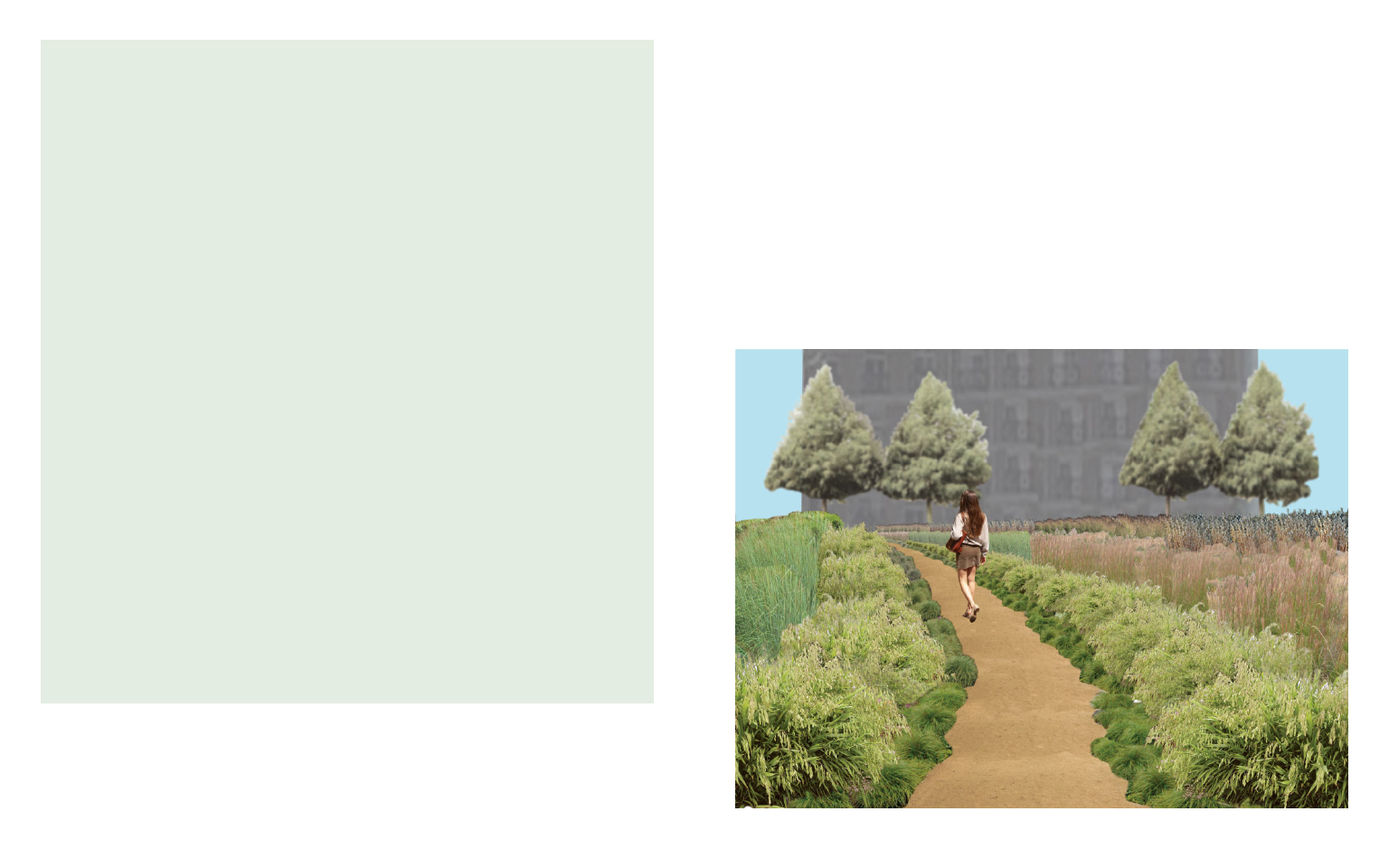
ATTENTION RESTORATION THEORY
e idea of the therapeutic landscape cannot be truly understood without explaining Rachel &
Stephen Kaplan’s Attention Restoration eory. Attention Restoration eory has four requirements
that are needed to create a restorative landscape. ey are as follows: ‘being away,’ extent, fascination, and
compatibility.
‘Being away’ is taking a vacation from whatever is occupying the mind and exerting mental fatigue.
While it could be a week at the beach that will only partially ful ll the ‘being away’ requirement. A person
must also remove themselves from the taxing stimuli. ey could ‘be away’ by sitting in their backyard
doing nothing. In contrast, changing a work environment to a cabin in the woods does not qualify as
‘being away’ when there is still draining work to be done in the cabin. ‘Being away’ needs an environment
that does not have any sort of distraction which would prevent the mind from being at rest.
Extent requires two properties to be fully de ned: scope and connectedness. Essentially you
much have interest while also being taken to another place. Becoming truly invested in a movie or a
play will draw interest and allow for exploration of this ‘new world’ enacting involuntary attention and
allowing for the brain to rest. “ ey must be places that are capable of capturing and maintaining our
interests” (Mencagli and Nieri, 58).
Fascination, which relies heavily on involuntary attention, lets the mind rest. “Fascination is
important to the restorative experience not only because it attracts people and keeps them from getting
bored, but also because it allows them to function without having to use directed attention” (Kaplan and
Kaplan, 184). Watching the sun rise or set is an ideal example of fascination.
Compatibility is nding a space that is going to work with the person and not against them.
If a person seeks peace and quiet, a playground a er school gets out is not compatible with their goals.
Instead they may seek a private garden or bench by a river. e landscape must be in favor of the same goal
as the individual in order for the space to be restorative.
Attention Restoration eory provides the guidelines for the creation of a therapeutic landscape.
pine; Tsuga candensis, Eastern
hemlock; and Taxodium distichum,
bald cypress. Planting these trees on
and around the berm created more
height and a larger screen to mask
Savoy Street and the apartment
complex on the other side of it. e
southeastern corner of savannah I
has a second entryway into the
park to allow for those coming
29
from the apartment complex to
easily access the site and experience
it from a di erent point of view.
eir journey would start with a
crossroads between heading north
toward the savannah and meadow the savannah I border, however, the path to intersect two landscape
or south into the forest.
northern part is bordered with Carex archetypes, savannah III and the
Savannah II is the appalachia, Appalachian sedge and forest. In order to blend the two in
innermost part of the site. Here Liatris microcephala, dwarf blazing a naturalistic way, the trees from
there is a smaller 1-foot depression star. e purple owers of Liatris the forest were brought out from
to allow for water to collect and microcephala are used tie into the the denser area and placed more
feed the grasses. While the land is colors of the neighboring meadow sparingly as they approached the
lower, the height of the plants in and are a blending point between savannah III zone. Savannah III has
savannah II will grow higher due the savannah and the meadow.
the basket weave pattern of grasses
to a more constant source of water
Savannah III is the most leading to the forest. As a barrier
and direct sunlight. e lower and transitional space in the entire site. and blending method Deschampsia
western edges of savannah II mirror It is the one area where there is no exuosa, wavy hairgrass is planted in
figure 25 - savannah perspective
30
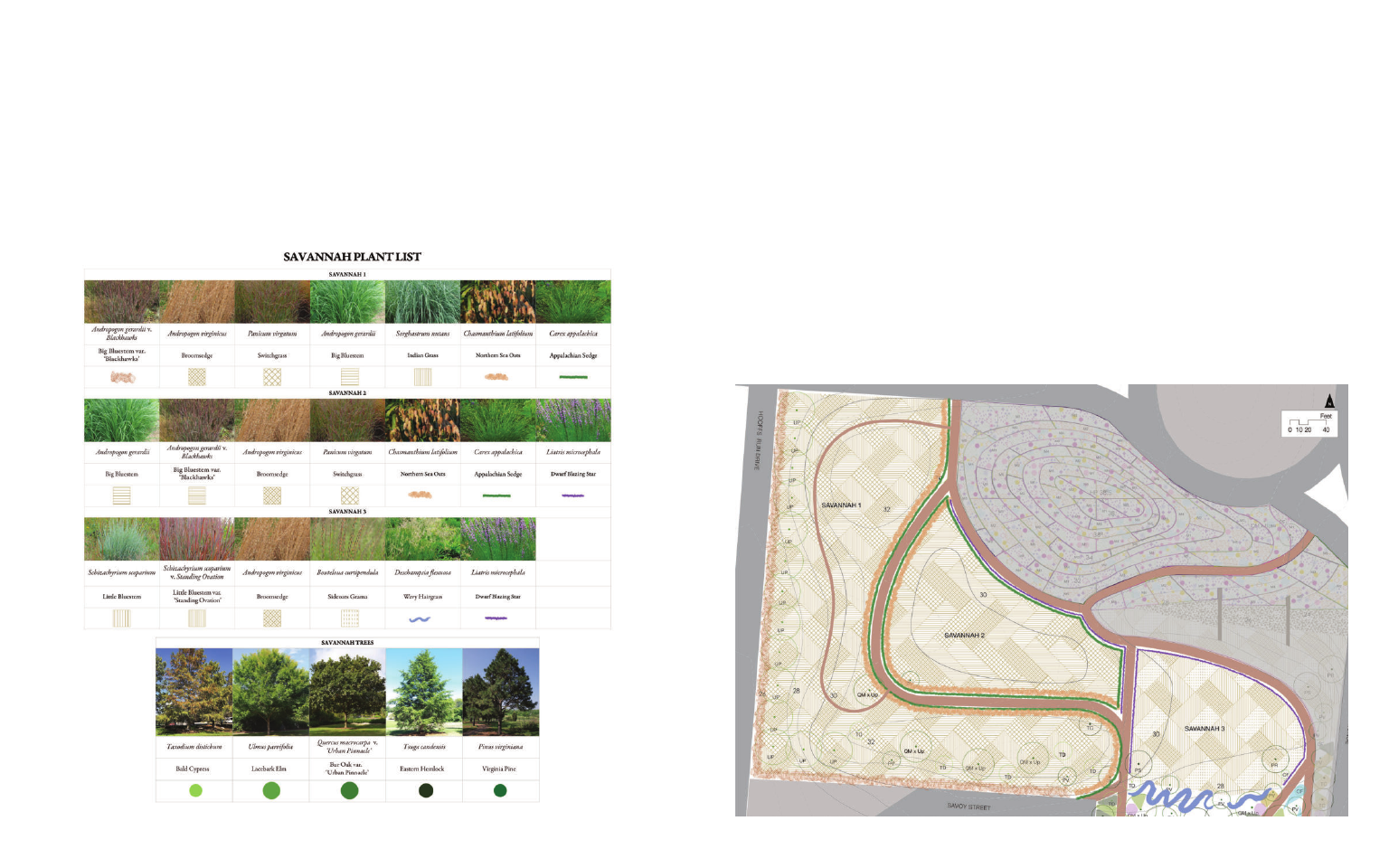
a loose spray. Deschampsia exuosa has a light seedy texture. Two efourthbrickworkpatternplantis
is a part sun/part shade grass which others are Schizachyrium scoparium, Andropogon virginicus, broomsedge,
works well in the transitional space little bluestem, and Schizachyrium which has a rough texture and
to blur the edge of the savannah into scoparium var. Standing Ovation, golden color. With the addition of
the start of the forest. One of the four little bluestem variation standing Deschampsia exuosa, Savannah III
plants represented in brick working ovation. Schizachyrium scoparium has the widest collection of textures
pattern in Savannah III is Bouteloua var. Standing Ovation brings deep of all the savannah areas.
curtipendula, sideoats grama, which red hues into the Savannah III zone.
All three savannah areas vary
in plantings, but are held consistent
by their brick patterning. A total of
twelve grass species are used across
the roughly four acres of savannah
space. e diversity across the three
zones gives an interlacing of hue
and grain, which can be enjoyed as
they sway amongst each other in the
wind. It brings a quiet and peaceful
view to someone seeking calmness
in their day.
figure 26 - savannah plant list
31
figure 27 - savannah planting plan
32

figure 28 - plant texture collage
33
34
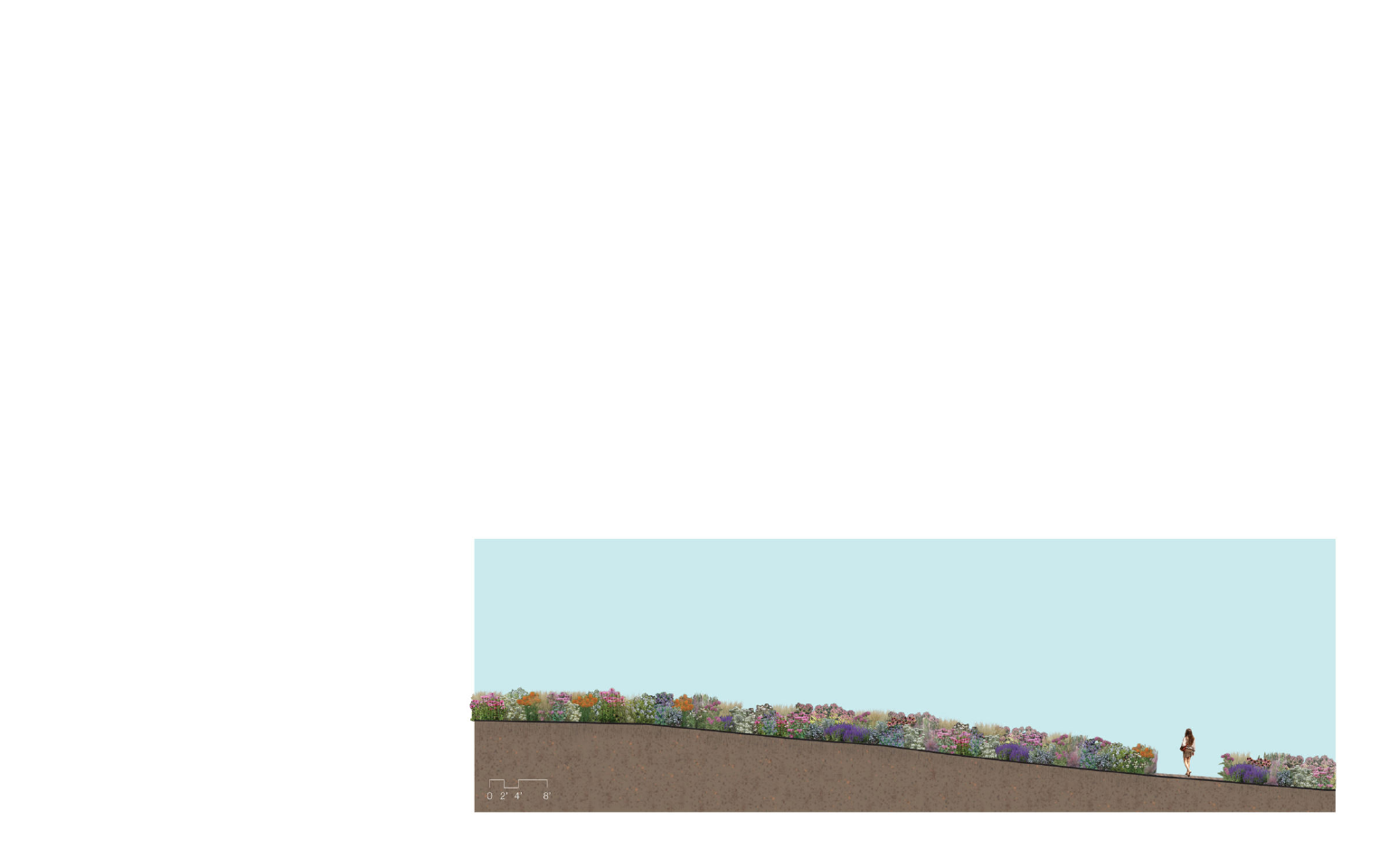
MEADOW
e role of the meadow is to Resilient Landscapes. Both had themselves. For example, matrix
elevate the site both guratively and di erent approaches to the problem, 1 does not intersect with another
literally. It is to be an explosion of which meant picking one or nd a matrix 1. Each individual matrix is
textures, colors, shapes, and species. combination of the two that would composed of ve oral species, one
e planting plan for the meadow work.
grass, and one species of crocus. e
was the most challenging part of
e meadow planting plan role of the crocus is to provide a pop
the Carlyle Solace Park design. is designed as a matrix-grid hybrid. of color in the early spring before
How do I go about planting a A radial grid was used to lay out the late spring/early summer plants
meadow? Especially if the meadow the sections of where the plantings begin to bloom. e following
is to look like a eld of wild owers, would be. e center of the circle species were used to populate the
completely naturalistic. What does was placed at the high point of the
a planting plan look like when I site, 38.5 feet in elevation. From
do not want the design to look like there, the radial grid was broken
there is a planting plan?
up every 15º moving outward from
Two designers were the center of the circle. e sections
researched heavily in an attempt were divided up at every 1-foot
to understand the meadow and contour line with the widths being
how to implement it. Piet Oudolf, based o the 15º radii. Each section
renowned landscape architect of varied in size but was bound by the
the High Line in New York City, 15º and topographic changes. From
and omas Rainier, co-author here a di erent matrix group was
of Planting in a Post Wild World: randomly assigned to each section;
Designing Plant Communities for the sections do not align next to
35
hill meadow:
• Amsonia hubrichtii, threadleaf bluestar
• Asclepias purpurascens, purple milkweed
• Asclepias tuberosa, butter y milkweed
• Aster cordi orus, common blue wood
aster
• Crocus chrysanthus ‘Goldilocks,’ snow
crocus
• Crocus tommasinianus, snow crocus
• Echinacea purpurea, purple cone ower
• Echinacea purpurea var. ‘White Swan,’
purple cone ower var. ‘white swan’
• Eryngium planum, sea holly ‘Blaukappe’
• Eupatorium stulosum, Joe Pye weed
• Monarda stulosa, wild bergamot
• Pycnantheum muticum, mountain mint
• Salvia x sylvestris ‘Mainacht,’ wood sage
May night
• Schizachyrium scoparium, little bluestem
• Schizachyrium scoparium var. ‘Standing
Ovation,’ little bluestem var. ‘standing
ovation’
Every species is represented
in at least two matrices and no
two matrices are the same. To best
represent the various plantings and
also show the overlap of species
between matrices, each species was
assigned an icon. Species that were
represented more than once, but
as a di erent cultivar had a similar
icon changed slightly in orientation
and color. is way a viewer could
easily identify the representation of
milkweed or echinacea on the plan
while still understanding there are
various cultivars shown in the plan. I
used the icons of each plant to create
a pattern speci c to the makeup of
each matrix. e result is ve unique
patterns that are then overlaid onto
their speci c section of the meadow
‘quilt.’ When the grid and contour
lines are removed all of the icons
representing the various plant
species in the meadow show up as a
fully naturalistic and random array
of plants. is gives the design of
the meadow the structure needed
for someone to plant it and the
looseness of a wild ower meadow
once fully planted and growing.
Creating a design that can be
planted with ease and also appear as
random as possible was challenging,
but necessary for the goal on this
portion of the site.
e meadow’s role is to
represent the beauty on the site. It
allows for the visitor to experience
beauty. Frederick Law Olmsted
wrote on the subject of “beautiful
figure 29 - meadow section
36

THE OUDOLF METHOD
Piet Oudolf, a Dutch landscape designer, is widely renowned as the designer of New
York City’s High Line, Chicago’s Lurie Garden, Pensthrope Garden in Norfolk, England. He
has designed public spaces as well as private residences in both North America and Europe. His
designs are highly texturized and he takes great care in selecting plants with year-round seasonal
interest. For example, the dried seed heads in the winter are just as important (and beautiful) to the
design as the same plant’s colorful owers in the summer. He suggests using plant combinations
that bring forth the essence of a wild habitat, allow for some spontaneity, and use plants that can
be recognized in their natural element.
Oudolf ’s designs are full of brushes of colors that sweeping across the space and the
breathtaking clumps of textures they create. Oudolf and Kingsbury de ne meadows and prairies
as a “typical habitat where one species — or usually one category — dominates, o en grasses or
grass like plants, but with a large number of other species present in much smaller numbers” (78).
When planting he uses a hierarchal design of primary plants (the main impact), matrix plantings
(a species used en masse), and scatter plants (which are just exactly as they sound). Oudolf ’s
plantings are made into groups and then placed around the site on a planting plan using icons and
colors to present where they go. He uses di erent iconography for the impact plants, the matrix
plantings, and the scatter plants so that they can be easily identi ed in their correct grouping.
“ e [role of the] matrix evokes the situation in many natural habitats where a small number of
species form the vast majority of the biomass, studded with large number of species present in
much smaller numbers, but which are a visually important element” (Oudolf and Kingsbury, 99).
Oudolf ’s work to create naturalism in the landscape is due to his “successful mixed planting…
which can function with relatively little maintenance almost as an arti cial ecosystem” (Oudolf
and Kingsbury, 210). His planting plans are just as striking as a piece of art found in a gallery.
However, according to Kingsbury, “the overriding factor which makes a Piet Oudolf planting
work for the long term is that his plants are long-lived” (236). e needs of the plant to survive
are no less important than their placement and role on the site.
37
figure 30 - textural details - oudolf’s planting at hummelo
figure 31 - lurie garden - chicago, illinois - designed by oudolf
38
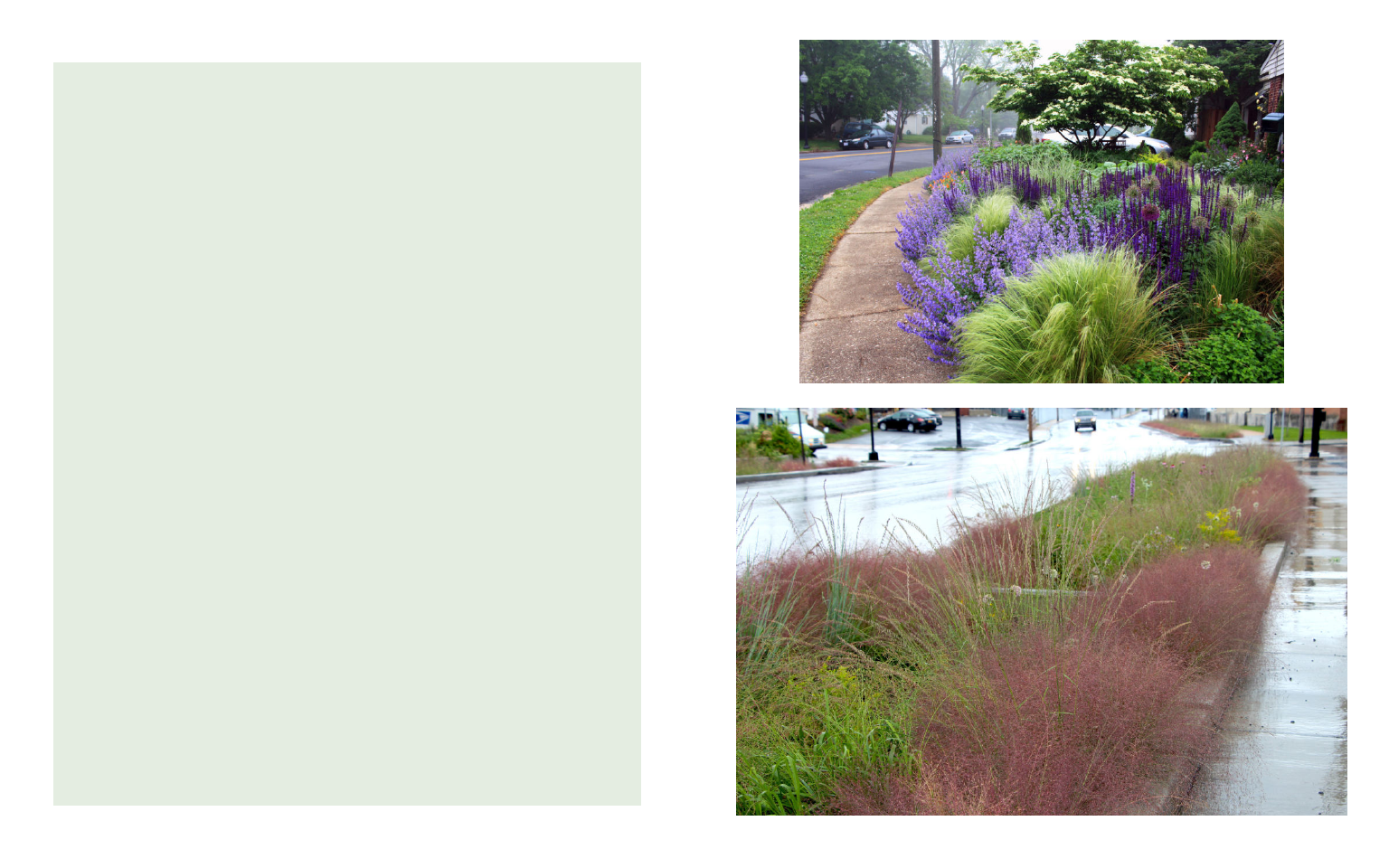
THE RAINIER METHOD
omas Rainier is the co-authors of Planting in a Post-Wild World: Designing Plant
Communities for Resilient Landscapes. He works with his co-author and fellow landscape
architect, Claudia West, at Phyto Studio in Arlington, Virginia. e work of Phyto Studio
focuses on designed plant communities. “Designing with plant communities can not only link
nature to our landscapes, but also bring together ecological planting and traditional horticulture”
(Rainier and West, 20). Resilient plant communities contemplate the ecological niches of plants
and use systems to create collections that are at peak function when together. “‘ e key is to pay
attention to how plants t together,’ Rainer said. ‘To pay attention to their shape and behavior.’
is involves not only their growth patterns aboveground, but their root types, which permit
plants that are surface-rooted, such as many ground covers, to coexist with deep-rooted meadow
owers and grasses” (Higgins). Which plants thrive in the what soil type? Does the plant’s root
structure work with its surrounding plants? Rainier and West suggest the following principles be
considered when designing resilient plant communities:
1. Related populations
2. Stress as an asset
3. Cover ground by vertically layering plants
4. Make it attractive and legible
5. Management, not maintenance
is requires signi cant learned knowledge of each plant’s ecological preferences. Knowing which
perennials grow best with which grasses or ground covers leads to a successful plant community.
While it may seem daunting at rst, Rainier and West state “our focus is on plants naturally
adapted to their speci c sites. It is the relationship of plant to place we want to elevate” (41).
e plant must be suitable for its corresponding archetype in order to be successful, regardless
of its status as native or exotic. Planting in a Post-Wild World: Designing Plant Communities for
Resilient Landscapes advocates a fresh look at planting plans that o en stipulate only using native
plants. According to Rainier and West, “the time is right for this shi in thinking” (62).
39
figure 32 - thomas rainier’s home garden - arlington, virginia
figure 33 - bio-retention planting - lancaster, pennsylvania - designed by phyto studio
40

figure 34 - meadow plan - ‘quilt’ view
figure 35 - meadow planting plan - matrix view
figure 36 - meadow planting plan
41
figure 37 - meadow plant list
42

natural scenery ‘[it] employs the with beauty, we can opt out of our
mind without fatigue and yet ordinary distractions” (Mosko and
exercises it; tranquilizes it and yet Noden, 17). Visiting the meadow at
enlivens it; and thus, through the Carlyle Solace Park is an experience
in uence of the mind over the in immersive environments. e
body, gives the e ect of refreshing landscape is so invigorating that you
rest and re-invigoration to the can let go of the day’s strife and allow
whole system’” (Stuart-Smith, 91). the brain to experience calmness.
Looking at something beautiful, “It is not the plants themselves that
like a piece of art in a museum, have power; it is their patterns,
releases dopamine and serotonin in textures, and colors - particularly
the brain. e lush, brilliant colors those that suggest wildness - that
of the meadow owers intermixed become animated as light and
with grasses is Carlyle Solace Park’s life pass through them” (Rainier
art piece. “Dopamine generates and West, 24). e meadow is a
a sense of purpose and a state of combination of wildness with a
optimistic expectation, and it boosts precision construction hidden
connectivity and communication within the roots of the plants.
throughout the brain” (Stuart- “ is is why it’s important to create
Smith, 102). Serotonin is the brain’s beautiful garden environments in
mood stabilizer; de ciencies in which we can lose ourselves enough
serotonin is linked to depression. to discover insights otherwise
An improvement of both dopamine hidden by our involvement with
and serotonin levels increases the busy unstimulated spaces that only
mental well-being of a person.
encourage distraction” (Mosko
When someone is in the and Noden, 29). e meadow is a
hospital, we take them owers to space to rest the eyes and take in a
make them feel better. e meadow di erent type of stimulation, that of
makes the visitor feel better. It our natural world.
gives them something else to think
about, look at, focus on as they
escape their day for twenty minutes
of respite. “When we are engaged
43
figure 38 - meadow elevation
44
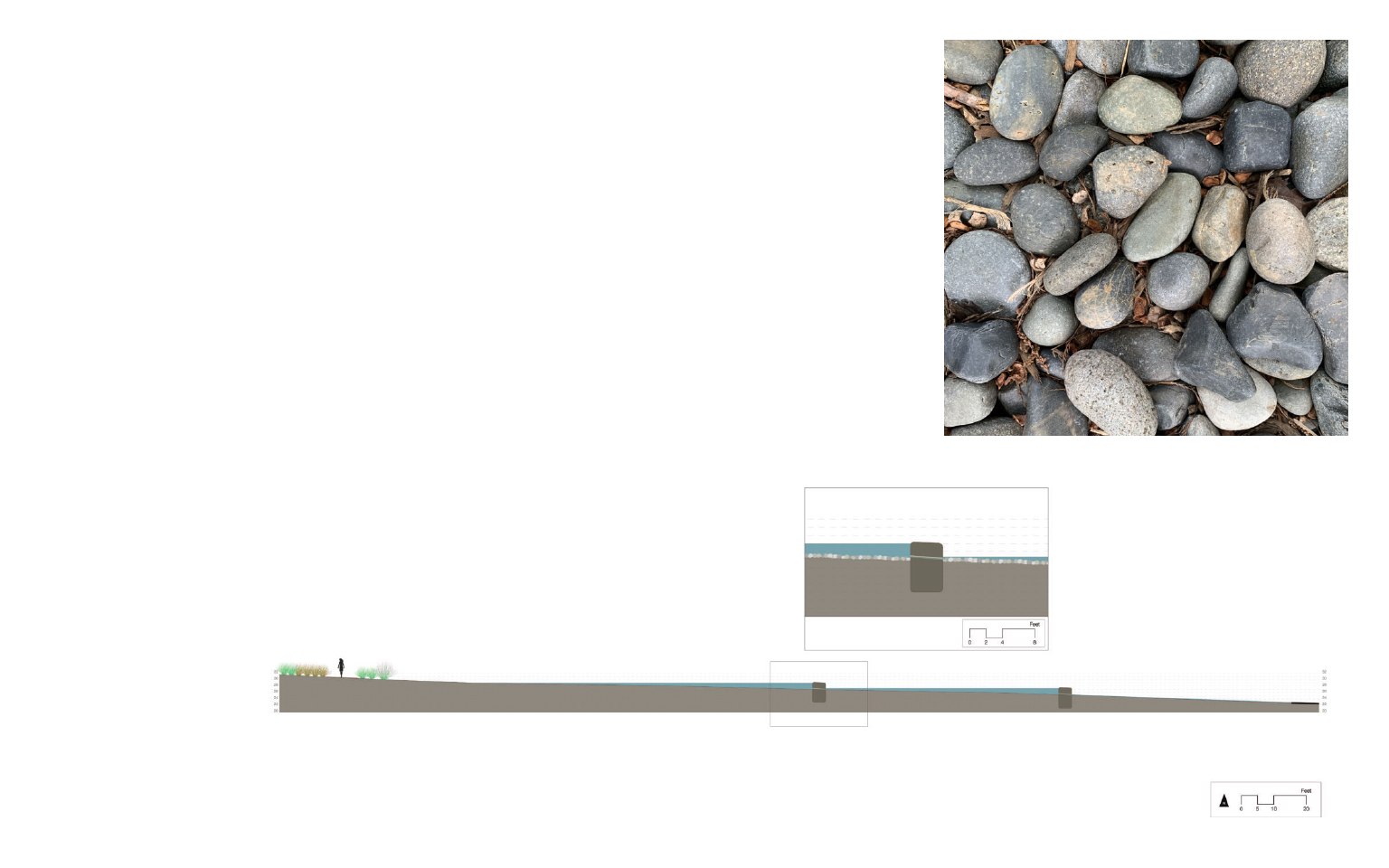
archetype. e center is a bed river
rocks no bigger than six inches. e
stones in the bed of the swale add a
di erent type of hardscaping, which
still appears as a natural site element.
e plantings are implemented as if
the path surrounding the swale did
not exist and the bed of the swale
S WA L E
was the dividing line. is helps
to amplify the naturalism sought
e existing topography had site and entering into Hoo ’s Run. be wide enough for a safe journey
a slight swale in it leading to Hoo ’s Lessening the sedimentation in this across. While slight, this is also a
Run. is existing feature is used watershed will help keep it owing reference to the stepping-stones seen
and ampli ed it by deepening the and prevent it from becoming a dry in a Japanese garden. e stepping-
cut of the swale and to allow for the stream bed in need of restoration. stone dams of the swale constitute
cut to ll the height needed to raise
One element of the swale the one area of the site that has
the meadow’s hill from the small design was to implement an area more obvious geometric structure.
in the site design. As the plants on
either side of the swale grow, they
will start to ll in and encroach the
swale bed lessening the hardness
of this portion and combing three
areas into one hybrid area in the
lower topography of the site.
mound that it was to something that a visitor may walk along or sit e sides of the swale are planted
more substantial. Deepening the down and relax; they needed to to match the nearest landscape
swale allowed for two check dams
to be installed formed from large
four-foot wide stones that span
the 27’ and 25’ contour lines. e
check dam works by slowly releasing
storm water through small four-
inch holes in the dam wall and
preventing what can be a toxic rst
ush collected in the urban area.
e swale will control the runo by
giving the water direction on where
to ow and collect. It will aid in
preventing extraneous runo and
sedimentation from leaving the park
45
46
figure 39 - example of river rocks
figure 40 - swale section
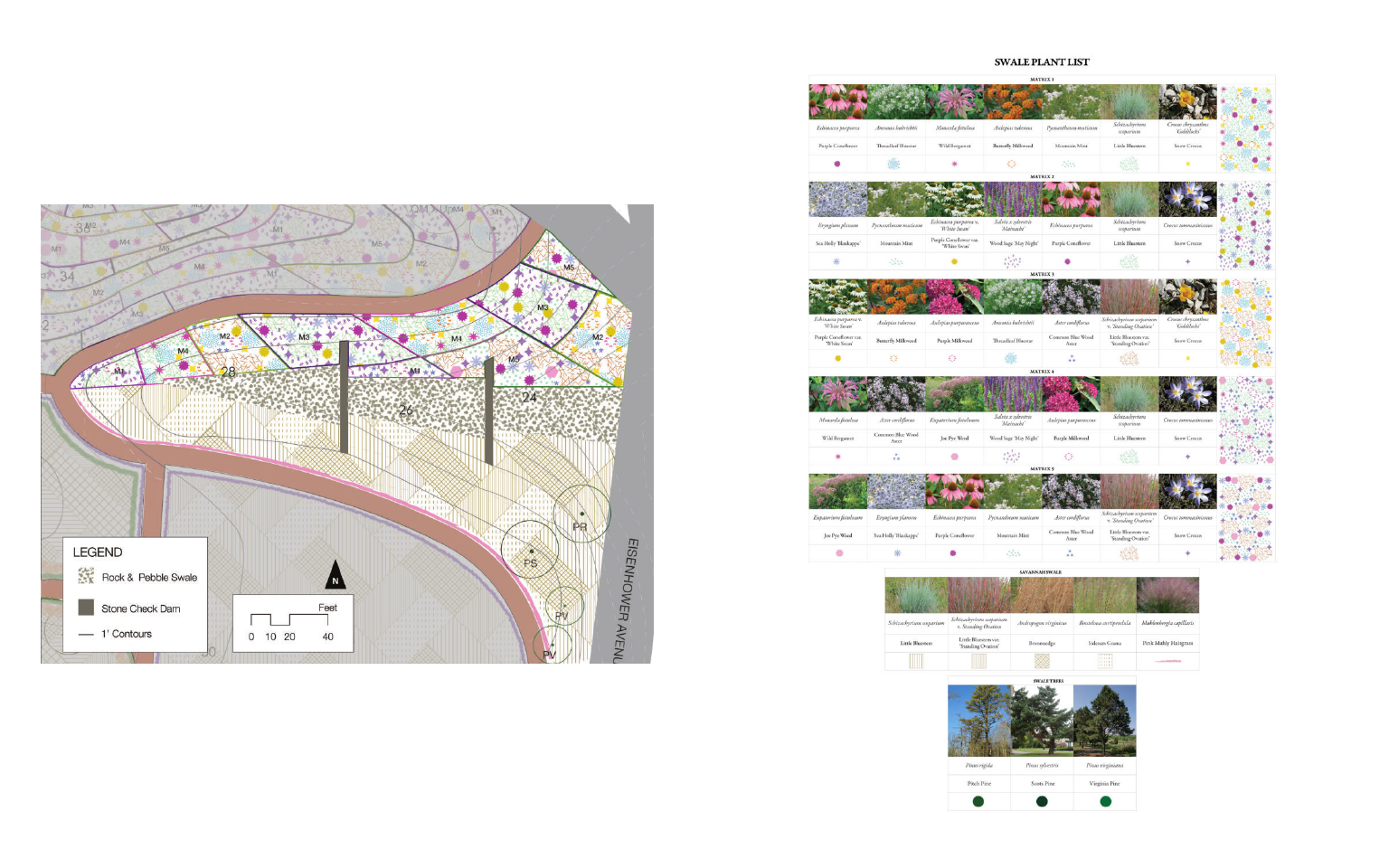
figure 41 - swale planting plan
47
figure 42 - swale plant list
48
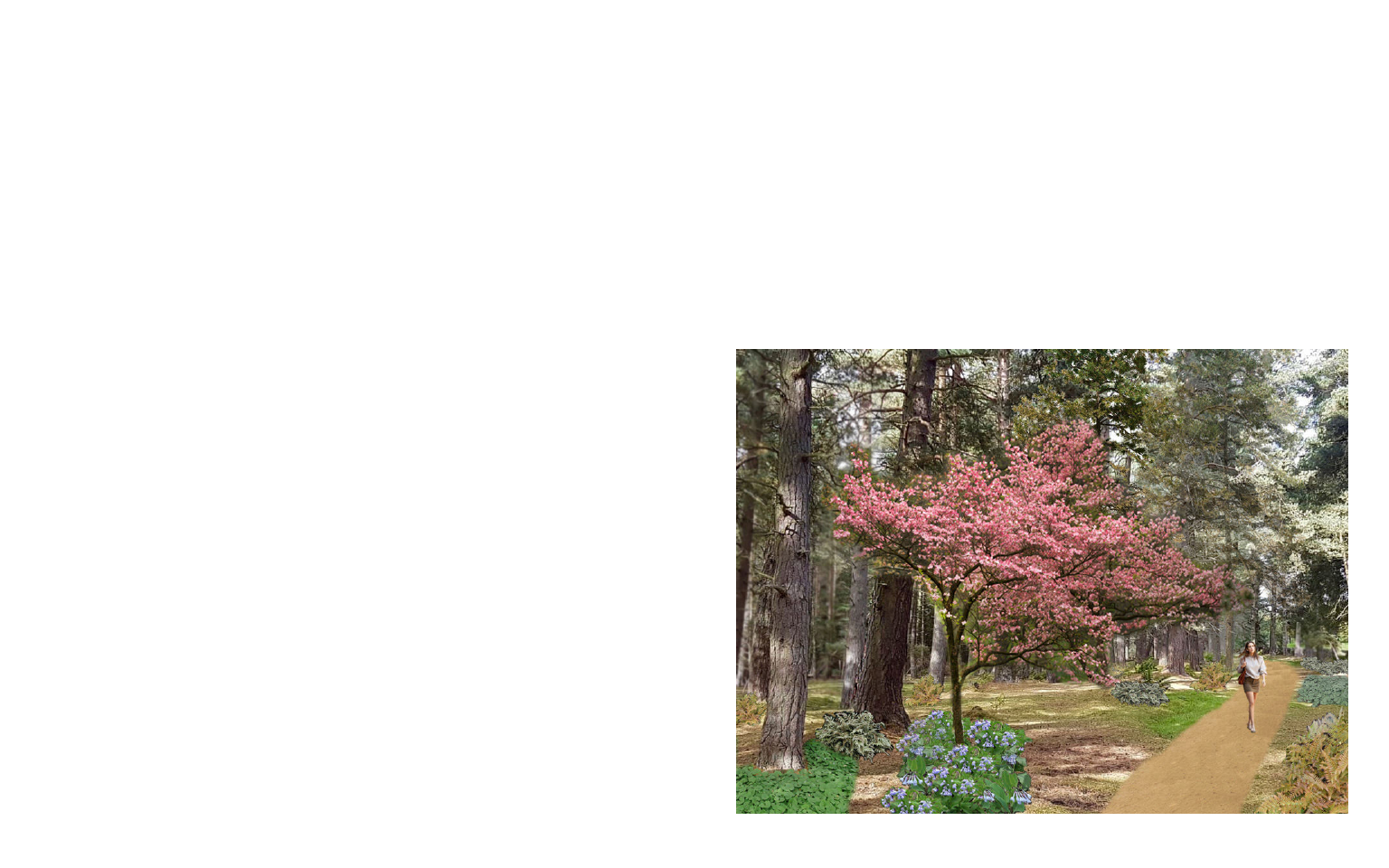
FOREST
e forest is the cohesive are lined with Pinus virginiana emissive potential of phytoncides
end to the three landscape and Tsuga canadensis. ese trees (Mencagli and Nieri, 93), which
archetypes in Carlyle Solace Park. are used as a border to shelter the makes it an ideal species to be located
It brings in di erent sensory space, quieting the inside of the on a forest bathing site. “Evergreens
elements than those experienced forest by blocking road noise and like pine trees, cedars, spruces and
on the rest of the site. e forest is screening the apartment complex. conifers are the largest producers of
made up of eight trees; three species
e Quercus genus lines the phytoncides” (Mosko and Noden,
of oaks: Quercus coccinea, scarlet edges of the paths and are intermixed 91). e pine core of the forest was
oak; Quercus macrocarpa, Bur oak; across the entire forest area. is created with this in mind, grouping
Quercus macrocarpa var. ‘Urban allows those walking along the species that are more fragrant
Pinnacle’; Bur oak cultivar Urban path to connect with the oak trees, with phyoncides than others in a
Pinnacle; plus three species of pines: hugging them if they want, or just central area to amplify the natural
Pinus sylvestris, Scots pine; Pinus sitting under them. e oaks here e ects of the environment. It was
rigida, pitch pine; Pinus virginiana, improve the canopy cover and aid equally important to enhance the
Virginia Pine; as well as Tsuga in the enhancing the visitors bio- percentage of negative ions in the
canadensis, Eastern Hemlock; and energetic body current, which can space. “Many forest environments
Cornus orida, owering dogwood. help reduce stress. e inner part suitable for the practice of forest
e dogwood is the only understory of the forest is lled with the oaks bathing also have a signi cant
tree. It brings color in the early and Pinus rigida. In the center of level of air ionization o en with
spring to the experience of the the forest there is an opening where a predominance of negative ions
site and subtly ties in the color of there is a grove of Pinus slyvestris. over positive ones” (Mencagli and
the meadow to the forest zone. Pinus slyvestris, Scots pine is listed Nieri, 112). e forest encompassed
e East and West of the forest as one of the species with greater a wider range of healing methods
49
as the more healing methods to guide visitors to enter the site each understory plant I assigned an
e understory of the at speci cs spots and not enter icon, similar to how I approached
forest is composed of Asarum from o the pathway, disturbing the planting in the meadow. Each
canadense, wild ginger; Dryopteris the plants. e entry point of the icon represents the general area
eerythrososa var. ‘Brilliance,’ forest is at the corner of Savoy where the plant will be, with the
autumn fern; Athyrium niporicum, Street and John Carlyle Street. understanding that as time passes
Japanese painted fern; Mertensia
e placement of the they will continue to ll in the
virginica, Virginia bluebell; Eurybia herbaceous layer of the forest is forest oor. Mertensia virginica
divaricata, white wood aster. e designed to allow the plants to is speci cally placed underneath
ferns are used heavily along the grow and expand lling the space all of the Cornus orida in a tear
outside edges of the forest to help over time. In order to represent drop or paisley-shaped formation.
create a barrier. e intention is the areas too start the planting of Originally, the goal was for the
figure 43 - forest perspective
50
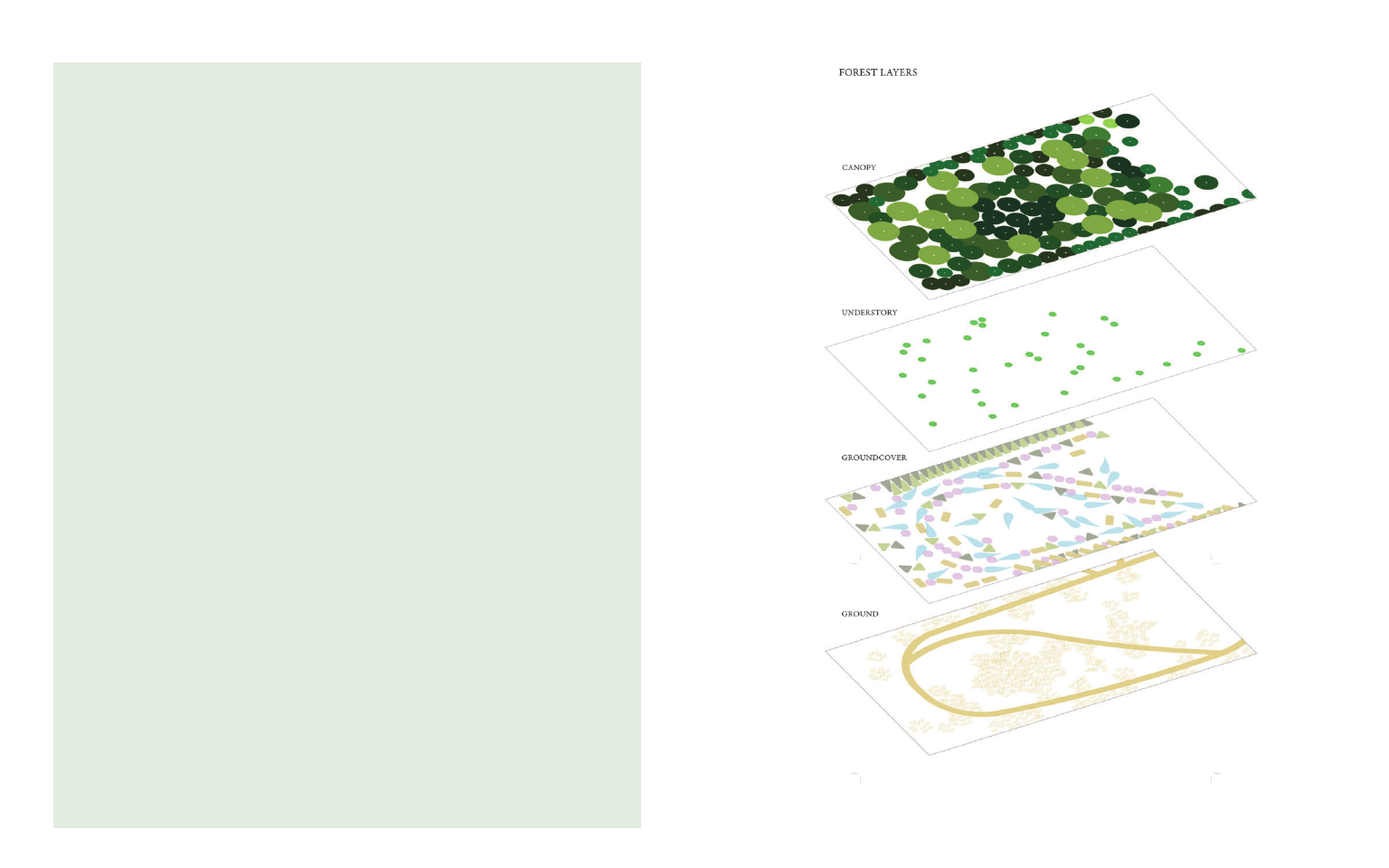
BIO-ENERGY & NEGATIVE IONS
e Quercus genus emits high bio-energetic resonance. “Plants emit bio-electromagnetic
elds that are able to in uence the state of our organs to varying extents” (Mencagli and Nieri,
128). e oak is considered highly bene cial as compared to others, like the walnut, which is
considered disruptive to a person’s energetic eld. In order to receive bene ts from the oak, a
person needs to be no further than “12 to 16 inches from the trunk” (Mencagli and Nieri, 133).
For even greater bene t, hugging the tree creates a bio-energetic connection and grounds the
person to the earth. “ e oak response with enthusiasm to the hug with a positive e ect on all
our organs, especially the nervous and immune systems, ovaries, adrenal glands, and the thyroid”
(Mencagli and Nieri, 132). Grounding is technique where the human body’s circuitry is realigned
with that of the Earth through direct contact. “Evidence suggests that the Earth’s negative
potential can create a stable internal bio-electrical environment for the normal functioning of all
body systems” (Chevalier et al.). Becoming more connected to the landscape, by being present in
it, is bene cial to human health.
Negative ions are the more bene cial of the two ions, one being positive, the other negative,
to human health. ese ions are “electrically charged molecules or atoms in the atmosphere…
formed when a gaseous molecule or atom receives su ciently high energy to eject an electron.
Negative air ions are those that gain an electron, while positive air ions lose an electron” ( Jiang et
al.). Areas of the landscape that have a higher concentration of negative ions are waterfalls (where
the water molecules are breaking apart as they hit rock) and areas of denser well-established plant
life, like a forest. “Unfortunately, however, urban and indoor environments do not even come
close to the ionization levels typical of more natural surroundings” (Mencagli and Nieri, 105).
is gives an even better reason to leave the o ce to go for a walk in a park, speci cally a forested
one. e expansion of urbanism is not only decreasing our green space, but at the same time
increasing the percentage of positive ions in the atmosphere. “Environments with a predominance
of negative ions are shown to be e ective in reducing states of stress, depression, and psychological
maladies connected to stressful events” (Mencagli and Nieri, 107). Additional tree canopy and
lush plantings will aid in the increase of negative ions and therefore the health of those who visit
these verdurous spaces.
51
figure 44 - forest layers axonometric
52
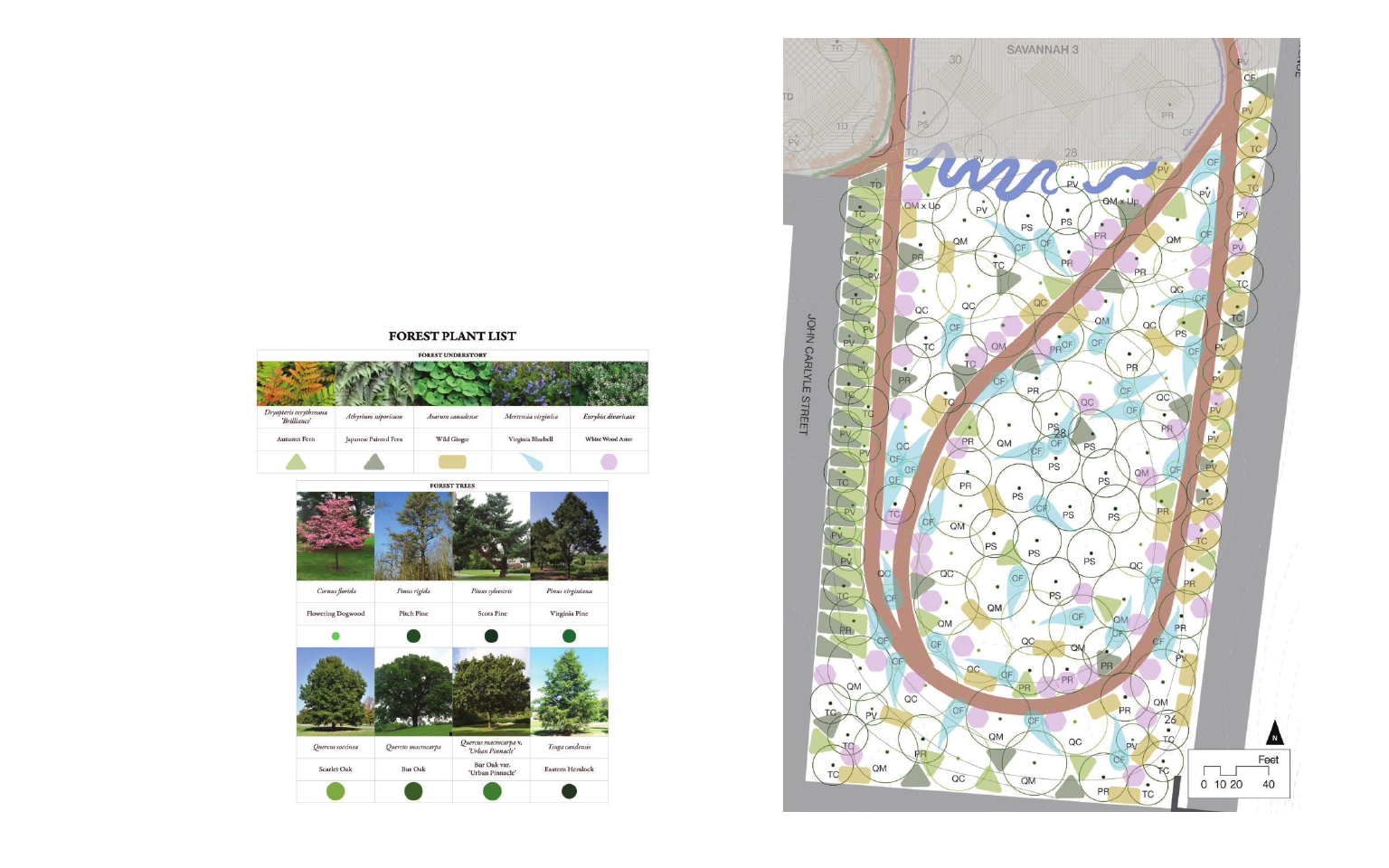
Mertensia virginica to appear to fade Athyrium niporicum and so on. be solely represented by the pine
away from under the Cornus orida Aside from the formation of the needles. ere is a strange so ness
so that the brighter oral colors of Pinus sylvestris grove in the center to a bed of pine needles when it is
the forest are together and produce of the forest the borders are the looked at. I wanted to create a pine
pops of color throughout the mostly most structured plantings in this oasis in the center of the forest. A
earth-tone journey of the forest. e archetype. is again, was mainly quiet place which could allow for
teardrop formation also mirrors the to guide visitors on where to enter someone to step into the area and
interior shape of the forest path. the site for the best experience. breathe in the phytoncides emitted
While this was unintentional, it
e inside core of the forest by the pines. e center of the forest
created a nice form of cohesion and is more barren with herbaceous is the epicenter of the entire space.
subtle poetry to the forest oor. plants. is is to allow the oor to Quiet, full of smells, full of texture,
e other forest oor
plantings are somewhat sporadic.
Eurybia divaricata, Asarum
canadense, Dryopteris eerythrososa,
and Athyrium niporicum all hug the
edges of the path on the inner areas
of the forest archetype. is allows
for the species to be experienced by
the visitor in various combinations
as they proceed through the park.
is changes on the eastern edge of
the forest where Asarum canadense
forms a stronger diagonal pattern
to break up the edge experience
in a more systematic way as the
visitor walks along the path
adjacent to Eisenhower Avenue.
ere are collections of Asarum
canadense, then Eurybia divaricata,
then Asarum canadense, then
Dryopteris eerythrososa followed
by Asarum canadense again, then
figure 45 - forest plant list
53
figure 46 - forest planting plan
54
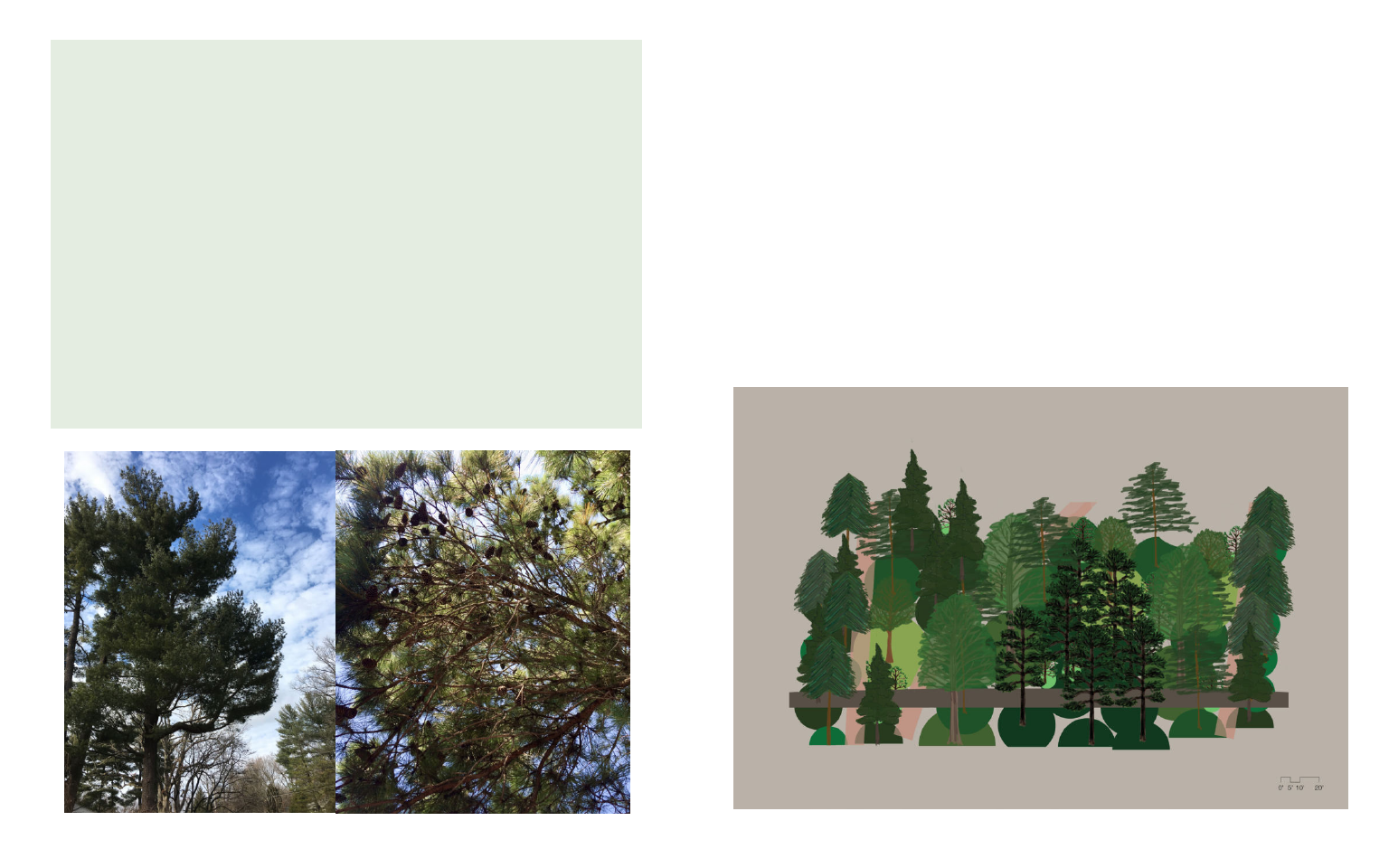
PHYTONCIDES
ere is a di erent smell when you enter a forest. It is something easily noticed, but hard to
identify. e smell comes from phytoncides. According to Dr. Qing Li, “phytoncides are the natural
oils within a plant and are part of the tree’s defense system” (89). ese are emitted by the trees to
ght against fungi, bacteria and insects. “ e main components of phytoncides are terpenes” (Li, 91)
which includes monoterpenes. A monoterpene is an organic compound that is emitted by a variety of
plants. It is a standard component of essential oils and many resins. “Essential oils have been known
to humans for thousands of years and their medicinal use is extremely widespread across all latitudes”
(Mencagli and Nieri, 79). Walking through the forest phytoncides are inhaled, by increasing the
amount of time we are in the forest, we increase the amount of time we are exposed to phytoncides.
Subjection to phytoncides boosts the human immune system. Additionally, “exposure to essential
oils [is known] to li depression and help with anxiety” (Li, 94). e more time spent in and around
phytoncides or forests with higher percentages of conifers the better a person will feel. A walk in a
pine stand, for example, is more than just an adventure or exercise, it is a healthy healing experience.
a calming space to allow someone to a sense of closure at the end of the
fully relax and spend time relaxing trip. Even if the journey takes the
andateasebeforeturningupthepath visitor back toward Hoo ’s Run
to walk toward their job or home. or the African American Heritage
e idea of a healing forest Park. It was important that the
started the entire project from a design of the site was further
philosophical level in my research reinforced by the forest element.
to a physical level in the Carlyle
neighborhood when I walked
through the urban forest. Shinrin-
yoku inspired the project so it is
tting that the end of the journey
through the Carlyle Solace Park be
the forest again. ere had to be
figure 47 - photo of conifers
55
figure 48 - forest center sketch
56

figure 49 - final collage
57
58
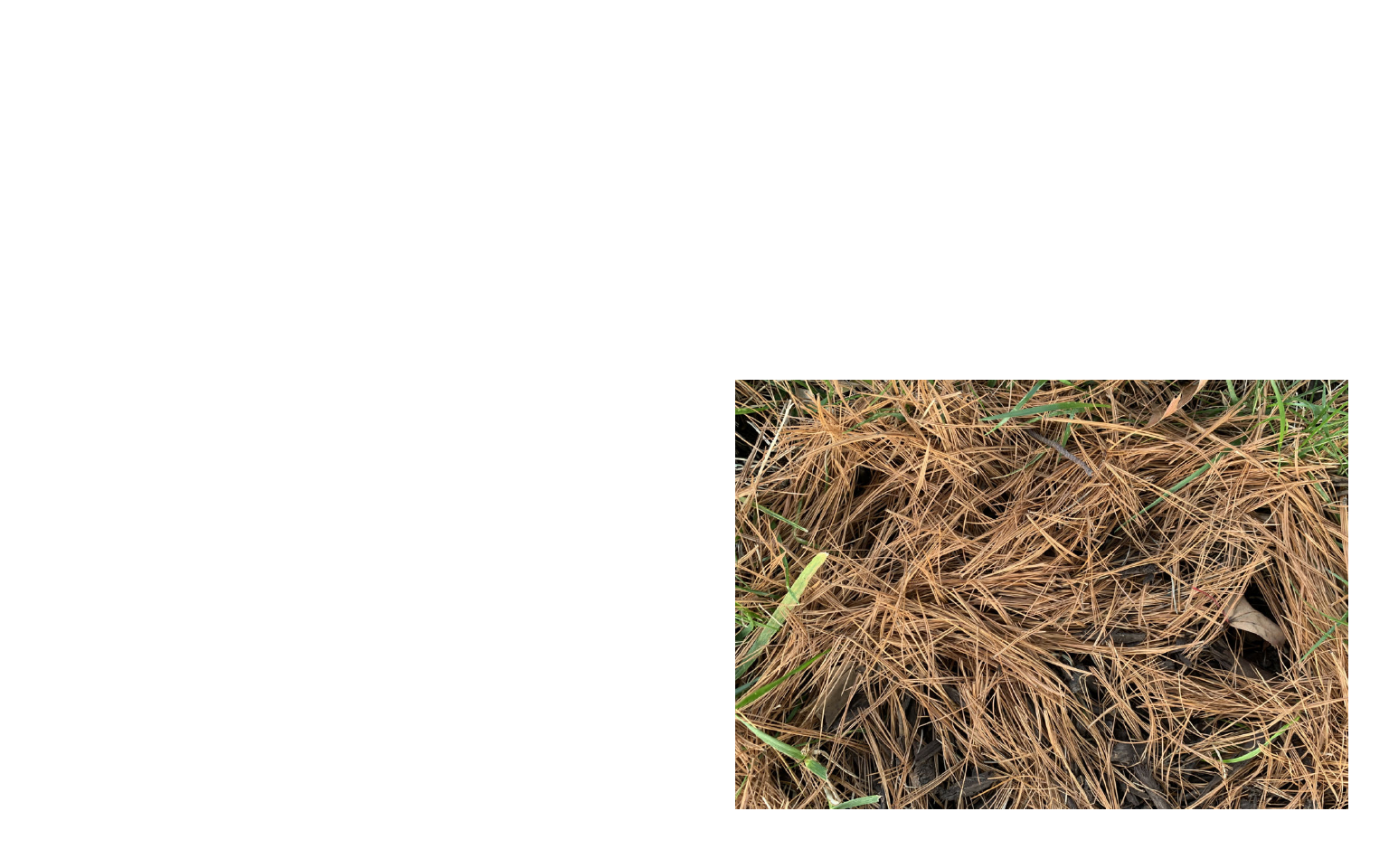
CONCLUDING THOUGHTS
is project started when I out when they are going through a Incorporating three landscape
bought a book. I was su ering from rough time? ere are therapeutic archetypes into one site was a way
stress and anxiety and wanted to gardens attached to hospitals, to expand outward from the success
nd another way to help myself heal. rehabilitation centers, or retirement that is seen with shinrin-yoku and
What I found was forest bathing communities, but we need more use other healing mechanisms
and an idea of how to help others and they must be in places easily found in the natural environment.
who su ered as well. According to accessible to anyone at any time. roughout this project I created
Mental Health America, one in ve
My research into many collages. ey show site
adults su er from mental illness. therapeutic spaces expanded my evaluations, project goals, textures,
Mental illness are ailments that view of how versatile the landscape and exude the feelings I wanted to
e ect behavior, feelings, and/or the is and how simple design decisions express with my nal product. e
mind. It is not the easiest type of can go a long way in creating healing nal collage is my way of showcasing
ailment to live with or to attempt environments. e design of this the new space that I had created, but
to heal from. It takes a lot of work space was vital to my goal to bring also showcasing my journey through
and it is not the most a ordable. awareness to mental health. is this project and through landscape
ose who su er seek solace - project is not the creation of a architecture. It expresses what
“comfort or consolation in a time of park. is project is the creation inspired me moving through this
distress or sadness” (Stevenson and of a health landscape. e space project. It shows the elements that I
Lindeberg) What makes a place had to be welcoming, a safe wanted to make sure to incorporate.
a solace? is was one of the rst environment, accessible, free of any ItincludessomeoftheworkthatIdid
questions I wrote to myself when I nancial requirement. It had to and elements I found inspirational.
started my thesis journey. How can evoke openness while still feeling Finally, it exudes my passion for
I create a space that people will seek like the safest place in the world. texture, color, and pattern. A space
59
that has serenity that has openness lessen people’s burden with the mental illnesses, I wanted the space
and has security all at the same time. landscape. is project is a space the to appeal and assist as much of the
And I hope that this does that and person who is living on the street urban population as possible. e
really creates this inviting space. and does not understand why they views of mental health care need to
Our public green spaces can do so are hurting, for the person who is be broadened and with broadening
much more to help those su ering working at a fast food restaurant the knowledge of a subject, we can
from mental illness. I designed a and does not have the funds to visit expand ways to solve it, look at the
place that serves as an example to a therapist or to see a doctor, for problem di erently. e Carlyle
leaders in city governments, urban the person working full time while Solace Park is an alternative method
planning, landscape architecture, trying to earn a degree and take care to heal not only an individual
and the mental health community. of their family all at the same time. but whole communities as well.
With this project I wanted to bring is can be their place, where they
to light the importance of mental can go and heal. Everyone’s life is
health and that there are ways to di erent and so are their struggles or
figure 50 - photo of pine needles
60
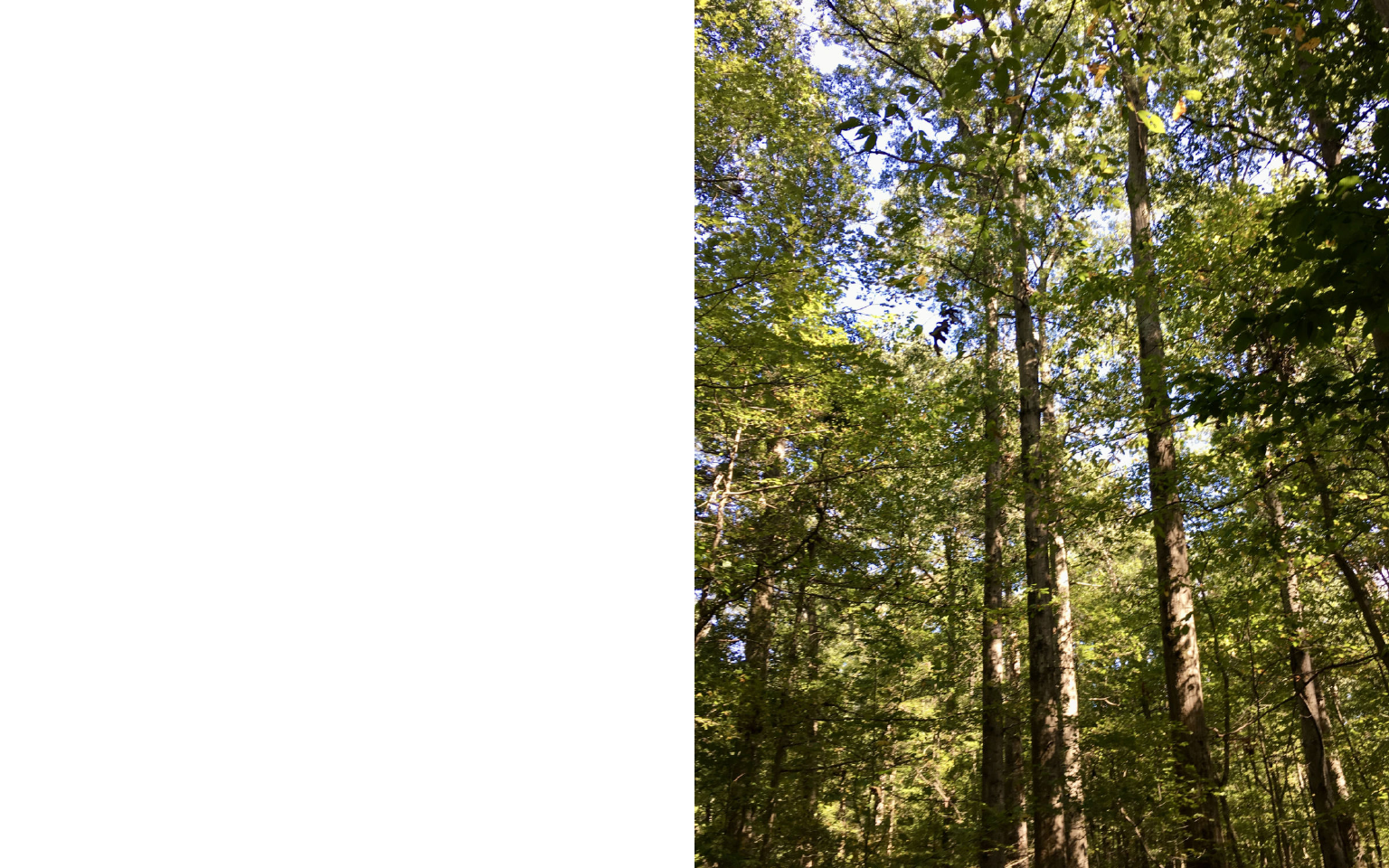
REFERENCES
Chevalier, Gaétan, et al. “Earthing: Health Implications of Reconnecting the Human Body to the Earth's Surface Electrons.”
Journal of Environmental and Public Health, vol. 2012, 12 Jan. 2012, pp. 1–8., doi:10.1155/2012/291541.
Frontiers. "Stressed? Take a 20-minute 'nature pill': Just 20 minutes of contact with nature will lower stress hormone levels,
reveals new study." ScienceDaily. ScienceDaily, 4 April 2019.
<www.sciencedaily.com/releases/2019/04/190404074915.htm>.
Higgins, Adrian. “Why Manicured Lawns Should Become a ing of the Past.” e Washington Post, 2 Dec. 2015.
Jiang, Shu-Ye, et al. “Negative Air Ions and eir E ects on Human Health and Air Quality Improvement.” International Journal
of Molecular Sciences, vol. 19, no. 10, 28 Sept. 2018, p. 2966., doi:10.3390/ijms19102966.
Kaplan, Rachel, and Stephen Kaplan. e Experience of Nature: a Psychological Perspective. Cambridge University Press, 1989.
Li, Qing. Forest Bathing: How Trees Can Help You Find Health and Happiness. Viking, 2018.
Mencagli, Marco, and Marco Nieri. e Secret erapy of Trees: Harness the Healing Energy of Forest Bathing and Natural Landscapes.
Rodale, 2019.
Mosko, Martin Hakubai, and Alxe Noden. e Sound of Cherry Blossoms: Zen Lessons om the Garden on Contemplative Design.
Shambhala, 2018.
Oudolf, Piet, and Noël Kingsbury. Planting: a New Perspective. Timber Press, 2014.
Rainer, omas, and Claudia West. Planting in a Post-Wild World: Designing Plant Communities for Resilient Landscapes. Timber
Press, 2016.
“Quick Facts and Statistics About Mental Health.” Mental Health America, 2021, www.mhanational.org/mentalhealthfacts.
Stevenson, Angus, and Christine A. Lindeberg. e New Oxford American Dictionary: ird Edition. 3rd ed., Oxford University
Press, 2010.
Stuart-Smith, Sue. Well-Gardened Mind: e Restorative Power of Nature. Scribner, 2020.
Yuen, Hon K., and Gavin R. Jenkins. “Factors Associated with Changes in Subjective Well-Being Immediately a er Urban Park
Visit.” International Journal of Environmental Health Research, vol. 30, no. 2, 2019, pp. 134–145.,
doi:10.1080/09603123.2019.1577368.
61
figure 51 - photo of forest
62
